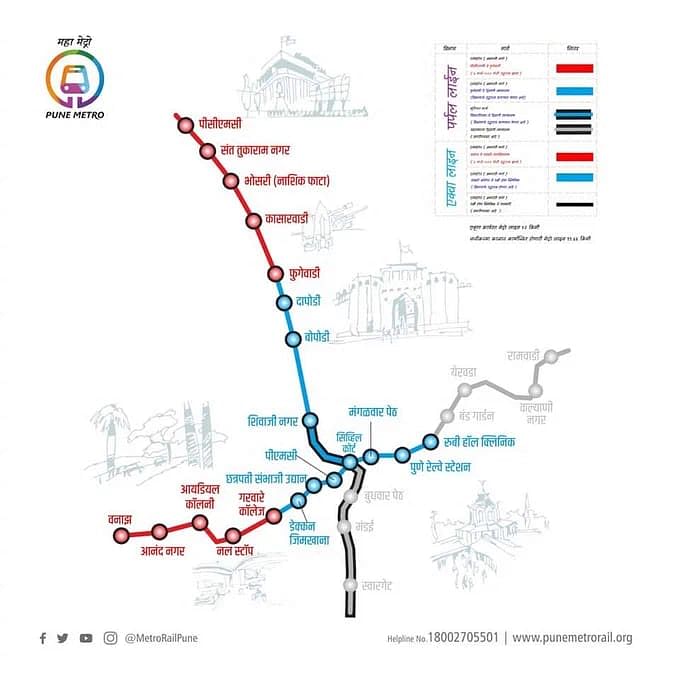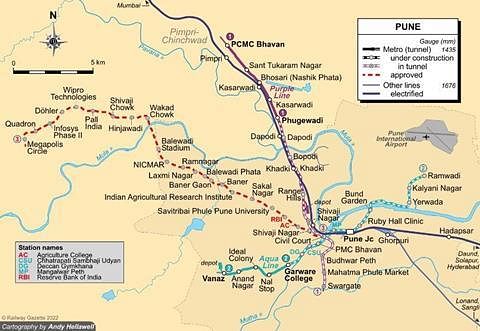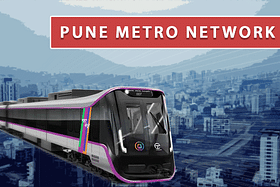This development will open approximately 24 km of the total 33 km network for public use, promising better transit utility for the city.
On 1 August, the inauguration ceremony, presided over by Prime Minister Narendra Modi, marked the commencement of services on two additional sections of the Pune Metro.
This development will open approximately 24 km of the total 33 km network for public use.
The newly accessible sections for commuters are from — Phugewadi to Civil Court and Garware College to Ruby Hall Clinic.
The Pune Metro Network
The operational Pune Metro Rail Project consists of two corridors — Line-1 and Line-2 — also known as the Purple Line and Aqua Line, respectively, with a total length of 33 km and 30 stations.
The Bhoomipoojan for the same was done by Prime Minister Modi on 24 December 2016 and the Maharashtra Metro Rail Corporation Limited (Maha-Metro) is the implementing agency for the project.
The 17.5-km-long Purple Line corridor from PCMC to Swargate has 14 stations. It passes through the industrial area of Pimpri-Chinchwad and further into old Peth areas of the Pune city.
This corridor includes a 11.4-km-long elevated stretch and a 6.1-km underground section between Range Hills and Swargate.
Further, the fully elevated Aqua Line starts from Vanaz Depot in east and goes upto Ramwadi. There are a total of 16 stations on this stretch and total length of this corridor is 15.7 km.
It was in 2022 that Prime Minister Modi had inaugurated two partial stretches of the network — one from PCMC headquarters to Phugewadi on the Purple Line and the other from Vanaz to Garware college on the Aqua Line.
However, this small stretch of the network was unable to fully meet the transit demands of the city’s population.
Due to its limited coverage, the route experienced low ridership and was often perceived as more of a joyride, with limited utility for daily commuting needs.
With the new extensions inaugurated, the Pune Metro has expanded its coverage to include several critical regions, making it more relevant and accessible to a larger population.
Amit Paranjape, a technology entrepreneur who closely tracks infrastructure, told Swarajya, “I am quite optimistic about the usage of the Metro Line-1 and 2 now. With the new routes connecting to the city centre, I expect a considerable increase in the usage of the metro network.”
According to Hindustan Times, the Maha-Metro is expecting a daily ridership of more than one lakh commuters on these routes.
The new section inaugurated between Phugewadi and Civil Court station is 6.9 km long having four stations. With this, the trains will run from Pimpri to Civil Court on the Purple Line.
The Garware College to Ruby Hall Clinic station section is 4.7 km long with seven stations — on the Aqua Line.

(Source: AmitParanjape/Twitter)
These sections connect the important places of the city like Shivajinagar, Civil Court, Pune Municipal Corporation office, Pune RTO and Pune Railway Station, and will reduce the travel time to the city centre to approximately 15-20 minutes, which currently by road takes around an hour.
Further to this, close to 10 km of Line-1 and Line-2 network remains under construction, which is expected to be operational by the end of 2023.
Integration Of The Three Metro Lines
Apart from the existing network, a Line-3 in the city is also undertaken by the Pune Metropolitan Region Development Authority (PMRDA) and the Tata-Siemens partnership.
The Line-3 was tendered and awarded on a PPP (public private partnership) model. The 23 km, fully elevated network will connect the Hinjawadi IT park and several newly-developing areas.
The commencement of construction on Line-3 was delayed due to Covid-related challenges and work finally began in March 2022. However, the progress has been rapid since then. By third week of July, Tata-led consortium had already erected close to 625 out of 925 piers.
Another concern that has been voiced is potential coordination challenges among multiple agencies working on different metro lines for the city’s network.
Paranjape, however, does not see this as a bottleneck and points out to the proposed integration between the three lines at Civil Court Station.
The new line will serve a significant population as it will run on a key route, outside the city centre, and will connect the Hinjawadi IT Park and Shivaji Nagar in the city centre.
He explained, “This network will connect some of the newly emerging areas, which will serve close to 300,000 Pune employees for daily commute and will be an important route to bring some relief from long traffic jams. The line is still in its early stages, and will probably take another two years to completion.”

Last-Mile Connectivity To Improve Accessibility
With the growth of Indian cities positioned as urban engines, the role of Metro in enhancing the urban transport ecosystems has been enormous.
In times when travelling within the city on roads has become an emerging issue for Pune and all growing cities, metro as a mass public transit with its dedicated infrastructure provides a convenient and smoother movement on high traffic routes.
The metro corridor for Pune, will also open up the surrounding land areas for higher economic potential.
Additionally, the upcoming lines also provide opportunities for transit-oriented development (TOD).
The increased FSI for the surrounding areas opens up densification of the region, allowing taller buildings for housing, commercial and IT parks, that can accommodate higher population and resources.
In addition, with the expansive network of the metro, there is also need for last-mile connectivity and feeder services, which is critical to improve accessibility to this mass transit system.
Paranjape explains that due to land scarcity, having large parking spaces under the metro stations becomes difficult.
Thus, there is a pressing need to prioritise last-mile connectivity solutions — which includes adding feeder buses, autos and other smaller public transportation modes that will connect the surrounding areas with the metro.
He believes that not only for Pune but also for all other cities, the metro network can reach its maximum potential by integrating additional infrastructure for last-mile connections.
The Delays And Political Inconsistencies For Infrastructure In Pune
There is no doubt that Pune has suffered heavily under successive state governments when it comes to infrastructure and urban governance.
During the 15 years of Congress-NCP (Nationalist Congress Party) government, not much was done to address the systemic and structural woes plaguing Pune.
The Pune Metro was also delayed due to litigation started by some Pune elites on potential damage to riverbanks, in addition to several debates concerning corridor alignment.
Numerous stakeholders advocated for elevated routes, while others argued in favour of underground sections, citing the city’s narrow roads and limited land availability as key considerations.
However, the underground proposal faced opposition due to the projected cost escalation of two to three times higher than the elevated alternative.
All of this was influenced by personal interests and individual benefits, which descended into nothing more than an exhibitionist “Not In My Backyard” — NIMBYism, and the government never pushed through these complexities.
When BJP formed the government in 2014 (this time with Shiv Sena as a post-poll partner), chief minister Devendra Fadnavis did kickstart several new projects.
Paranjape credits Fadnavis for playing a significant role in accelerating the Pune Metro project. After assuming power in 2014, Fadnavis demonstrated a determined focus on resolving the project’s stalled situation.
He took initiative to organise meetings with citizen groups and other stakeholders to address the complexities involved and expedited the progress of the project.
“Such strong political will is crucial in driving forward ambitious development projects like the Pune Metro,” Paranjape added.
Furthermore, it was Fadnavis who addressed the longstanding demand to improve mass transit connectivity to Hinjawadi and other emerging areas of Pune.
In 2017, he took the initiative to push for the development of Line-3 in the metro network and explored various budget options to make it feasible.
As a result of substantial demand for the PPP model, the development of Line-3 was awarded to Tata-Siemens JV.
In 2015, the PMRDA was established to complement the existing administrative bodies, Pune Municipal Corporation and Pimpri-Chinchwad Municipal Corporation.
PMRDA was assigned the responsibility of coordinating the development of Line-3 in the metro network.
According to Paranjape, despite the progress made in some areas, many key infrastructure projects in the Pune region (eg, Ring Road, New Airport, Long-Term Water Allocation & Arrangement, Metro Expansion, etc) are moving at a very slow pace.
The city still lacks a strong local political ownership of these projects. Such ownership is critical to push these projects with the state/central governments and for their effective implementation.
The need for strong and proactive local leadership is crucial for the city’s infrastructure development over the coming decades.


